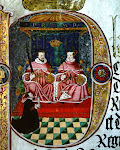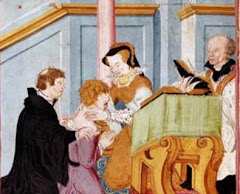
Yesterday I came across an article by Cristy Beemer published only a month ago on ‘The Female Monarchy: Rhetorical Strategy of Early Modern Rule’ (Rhetoric Review, 30, 8, pp. 258-74). The article explores the manner in which Mary and Elizabeth, England’s first queen regnants, presented themselves to a kingdom accustomed only to male rulers. Beemer identified Mary and Elizabeth’s tendencies to employ ‘the figures of the spouse, the mother, and the maiden to embody conventional roles for women in Tudor society’ (p. 259) though naturally these two occupied very remarkable roles for women of that age. Unlike other ‘mothers’ and ‘maidens’ they were not answerable to a male figure. Like their fellow Tudor monarchs, they expected to be recognised as the superior authority in the realm. Their bodies, Beemer argues, naturally invoked traditional gendered roles but at the same time their speech denied such roles. In other words, Mary and Elizabeth did not adopt submissive language but rather formulated speech that demonstrated their authority, their independence as rulers – their right to govern as powerfully and freely as their male predecessors.
But it is Beemer’s specific focus on Mary’s speech that I wanted to draw attention to. Like several recent historians, namely Judith Richards, Beemer argues that Elizabeth had a lot to thank her sister for as Mary of course governed first, challenged preconceived notions of female rule first, tested the waters so to speak, and made mistakes which proved equally valuable for Elizabeth. It is Mary’s speech before the Guildhall in 1554 that Beemer focuses on specifically. In 1554 the rebels of Wyatt’s uprising (primarily a protest against Mary’s prospective marriage to Philip of Spain) marched towards the city of London and the authorities were anxious that they would receive a warm reception once they got there or at least could not be held outside the city. Mary, who was advised to leave the capital, decided to stay and give a rousing speech at the Guildhall, which won her acclaim and plenty of support. During the speech, Mary declared that she was,
‘...wedded to the realm and laws of the same (the spousal ring whereof I have on my finger, which never hitherto was, nor hereafter shall be left off), you promised allegiance and obedience to me’ (p. 263).
Beemer points out that Mary very deliberately avoided calling herself a ‘wife’. She is ‘wedded’ to her kingdom but she employs the word ‘spouse’. She does not cast herself in the submissive role of a wife who was expected to obey her husband duly. Thus Mary gives her subjects no reason to believe they hold the power to command her; ‘Mary takes on the role as the person to whom obedience is sworn’ (p. 264). Beemer concludes ‘in one of the first examples of the strategy of gender play that female monarchs used to establish ethos, Mary will not be a wife to England, but rather, a husband’ (ibid).
In the same speech Mary went on to refer to herself as a ‘prince and governor’ instead of just using the term ‘queen’. Beemer points out (and I never noticed this before), that the Oxford English Dictionary attributes the first reference to a female sovereign as ‘prince’ to Geste’s 1560 sermon where he is referencing to Elizabeth I.* But Mary endorsed this term as early as 1554 (Beemer does point out rightly that the Guildhall speech was first recorded after Mary’s death but if accurate, and there is wide consensus that the speech is correct, it was still said by Mary six years before Geste used the term). Elizabeth described herself as ‘prince’ on numerous occasions. She was obviously supporting existing terminology advanced earlier by Mary who was keen to emphasise her similarity to male counterparts.
As everyone knows, Mary went on to marry and hoped the union would produce children, namely that longed for Catholic Tudor-Habsburg heir. How did a pregnant queen, or one who hoped of bearing heirs in the immediate future, continue with her image as a ruler whose power and rights matched a king’s? Beemer points out again that Mary continued this dual role; she emphasised her female body, namely her ability to produce children but in the same breath she explained that she hoped to continue the dynastic line like ‘my progenitors have done before’ (p. 265). Beemer explains that ‘Mary’s careful choice of the word progenitors is rhetorically savvy. Unlike the neutral gender marking of the Latin origin of prince, princeps, the term progenitors is gendered masculine in the Latin. Like the male princes before her, Mary’s ruling progenitors are exclusively male. Evoking a history of men, the discussion of succession is changed. Mary places her fertility on a level playing field with the men who came before her; the issue is one of succession only and not complicated by her gender. Although her female body signifies difference, her single status is no more problematic than any of the single men who ruled before her.’ (Ibid). The rest of the article chiefly concerns Elizabeth ‘mirroring’ her sister. And if we credit Beemer’s arguments, she was a useful model of queenship to follow.
Beemer’s article is well worth reading and I probably haven’t done it enough justice here. She is not the first, nor probably the last historian to draw attention to the legacy Mary left to Elizabeth, an inheritance which has forever been seen in a negative fashion (loss of Calais, religious turmoil, etc), but which was more fruitful than many have liked to admit.
Full article: Cristy Beemer, ‘The Female Monarchy: Rhetorical Strategy of Early Modern Rule’, Rhetoric Review, 30, 8 (2011), pp. 258-74.
* For those who don’t have a subscription to the OxfordED, here is the relevant entry:
Prince
Applied to a female sovereign. Obs.
1560 Geste Serm. in H. G. Dugdale Life (1840) App. i. 191 Let us low our prince [sc. Q. Eliz.],‥nothing thinking sayeng or doyng that may turne to hyr dyshonor, prayeng all way for hyr long and prosperus reigne.





